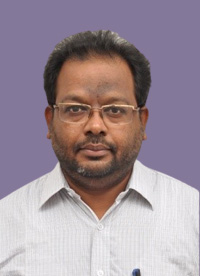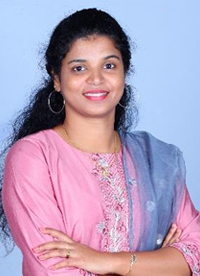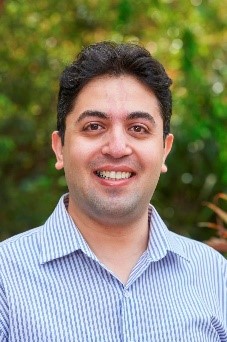

Prof. Jaffar Ali Mohammed
Pondicherry University, India
Research Area: Bioenergy, biophotonics, biosensors, biofuels, photocatalysis, solar biofuel
BIO: Prof. Jaffar Ali Mohammed was graduated in College of Engineering, Anna University(M.Sc.) in 1988 and graduated in Indian Institute of Science, Bangalore (Ph.D.) in 1998. he joined the Department of Green Energy Technology atPondicherry University in 2010 and he became a full professor in 2016 at IPondicherry University. He has an H-index of 16, His research expertise in Bioenergy, NanoBiology, soft Condensed Matter, Biophotonics and so on.

Prof. K. K. Aruna
Rathinam Research Center, Rathinam Technical Campus
Research Area: Electrochemistry, materials science, fuel cells, batteries, supercapacitors, Green hydrogen generation
Speech Title: Materials Towards Electrochemical Energy storage and conversion systems
BIO: Dr. K. K. Aruna is an electrochemist passionate about exploring materials for energy storage and conversion systems. She was awarded Ph.D degree in Nanoscience and Technology (Interdisciplinary Physics), from PSG Institute of Advance Studies, Coimbatore, Tamilnadu, INDIA for her thesis entitled “Novel Three-Dimensional Nanocarbon Hybrid Networks Modified with Noble and Non-Noble Electrocatalyst for Efficient Hydrogen Evolution Reaction”. Her research is focused on tuning, engineering and analyzing novel electrocatalyst materials for energy storage and conversion systems namely water electrolyzers for H2 production, Fuel cells for energy generation, supercapacitors, and batteries as charge storage devices. She has published 25+ papers in peer-reviewed international journals. She serves as a reviewer for some reputed journals like Carbon, International Journal of Hydrogen Energy, Journal of Materials Research, etc. She also leads as Guest Editor for few special issues like ‘Measurement Sensor’, ‘Current Materials Science’, ‘Green Materials’ etc. She has experience in developing membrane electrode assemblies for electrolyzer and fuel cells. Also, she works on coin cell assembly for batteries and supercapacitors, in collaboration with national-level institutions and companies. She takes immense pleasure in working individually and with a team where knowledge can be shared and ideas can be explored. She is profoundly interested in transporting research works to the technological readiness level (TRL), which can be channeled toward the commercialization of products. She runs a few government-funded projects namely from the Aeronautical Research and Development Board, UGC-DAE, IIT-TIH, and BRNS as Principal Investigator and Co-Investigator. She is actively involved in national and international level collaboration for clean and sustainable energy applications. She is an awardee of “Short-term visiting-scientist from the University of Bayreuth, Alexander Von Humboldt Centre for Excellence, Germany, and also from the Indian National Science Academy (INSA).

Associate Professor Farhad Shahnia
Murdoch University, Australia
Speech Title: Virtual Power Plants and Their Regulatory Aspects in Decarbonization of Electrical Energy Sector
Associate Professor Farhad Shahnia received his PhD in Electrical Engineering from Queensland University of Technology (QUT), Brisbane, in 2012. He is currently an A/Professor at Murdoch University. Before that, he was a Lecturer at Curtin University (2012-15), a research scholar at QUT (2008-11), and an R&D engineer at the Eastern Azarbayjan Electric Power Distribution Company, Iran (2005-08). He is currently a Fellow member of Engineers Australia, Senior Member of IEEE, and member of the Australasian Association for Engineering Education.
Farhad’s research falls under Distribution networks, Microgrid and Smart grid concepts. He has authored one book and 11 book chapters and 250+ peer-reviewed scholarly articles in international conferences and journals, as well as being an editor of 6 books.
Farhad has won 5 Best Paper Awards in various conferences and has also received the IET Premium Award for the Best Paper published in the IET Generation, Transmission & Distribution journal in 2015. One of his articles was listed under the top-25 most cited articles in the Electric Power System Research Journal in 2015 while one of his 2015 journal articles has been listed under the top-5 most read articles of the Australian Journal of Electrical and Electronics Engineering. He was the recipient of the Postgraduate Research Supervisor Award from Curtin University in 2015 and the Australia-China Young Scientist Exchange Award from the Australian Academy of Technology and Engineering in 2016.
Farhad is currently a Subject Editor, Deputy Subject Editor, and Associate Editor of several journals including IEEE Access, IET Generation, Transmission & Distribution, IET Renewable Power Generation, IET Smart Grid, IET Energy Conversion and Economics, and International Transaction on Electrical Energy Systems and has served 40+ conferences in various roles such as General, Technical, Program, Publication, Publicity, Award, Sponsorship, and Special Session Chairs.
Farhad has led the IEEE Western Australia Section as the 2020-2021 Chair, and was the 2019 Founding Chair of the IEEE Western Australia Industrial Electronics Society (IES) Chapter. He was the 2023 Vice-chair of the IES’s Technical Committees on Smart Grids.
